War Space

The current cosmos is quite peaceful. Joint crews of the ISS, unarmed spacecraft. But it could have been different. About the various space weapons, from personal weapons to space battleships, this post.
Personal weapon
PM
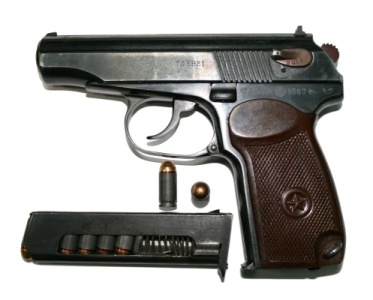
On April 12, 1961, along with Gagarin, the usual Makarov pistol went into space as part of a portable emergency reserve (NAZ). The idea is quite logical - in the event of a non-standard landing, it could occur from the south of Greenland to the extreme northern points of Antarctica, and the need to shoot from wolves, bears or tigers could well have arisen. PM was part of the NAZ until 1986, cases of application for its intended purpose is not fixed.
TP-82

In 1965, the ship "Voskhod-2" with cosmonauts Belyaev and Leonov landed irregularly in the snowy taiga of the Perm region, 75 km from the nearest town. Glade was not close, the helicopters could not sit down, so Belyaev and Leonov spent three days in the winter forest. Warm clothes were thrown from helicopters, on the second day rescuers arrived, but, in any case, the experience was not pleasant. There are stories on the Internet about wolves / bears, which astronauts had to drive away, but I think these are bikes, - the sources who directly participated in those events (Chertok, Kamanin) do not write about this (and the real danger to life would be an emergency which would be fixed). Nevertheless, it is Leonov who is considered the initiator of the creation of special weapons for the survival of astronauts. In 1979, when visiting the armory in Tula, he expressed the desire to have a special multi-functional weapon. The gunsmiths were interested in the idea, and they made a triple-barreled combined pistol TP-82 with two smooth 32-gauge barrels (12.5x70) and a special 5.45x40 rifled gun. Three types of ammunition were developed for weapons: shotgun and signal for 32 caliber and 5.45 x 40 bullet. TP-82 was part of the NAZ from 1986 to 2006. By 2006, the cartridges were out of warranty, and there was no point in making a new desire. For almost fifty years of manned space flight, the need to use weapons did not arise.
In more detail about TP-82 it is possible to esteem here .
Steel arms

American astronauts in the survival kit had nothing shooting. The astronauts "Mercury" were Astro-17 knives, made by a small company for specials. order. The Apollo survival kit included a machete:

Since 2006, Russian cosmonauts have only cold weapons left in the survival kit: a knife and a machete, and the signal cartridges for the TP-82 have been replaced with signal rockets.
')
Chemical weapon

Astronauts "Mercury" capsule nominally sprinkled, so the equipment included a "chemical weapon" - a repellent from sharks.
In more detail about the American equipment it is possible to esteem here .
Laser weapon

The idea of creating military orbital stations (about them below) led to a logical question - what if a potential enemy arrives, looks, gets us out of something or takes on boarding and drags us into the country to learn our secrets? It was necessary to arm the military astronauts. In 1984, the project began the development of military weapons for astronauts. And the achievements of technical progress led to the idea to create a laser gun. The design was very interesting. Disposable chemical flashlights were used as “cartridges”. The composition of zirconium foil and oxygen gave a flash of three times more powerful than the usual magnesium-based compositions, which included in the lamp metal salts “customized” the flash spectrum to the absorption spectrum of the active element. The active element itself was also quite unusual for that time - it was a fiber laser . The flash lamps were in the classic holder for eight “rounds”. To ignite the lamp, an electric discharge was used, for which the standard nine-volt “Krona” stood on the pistol. It is alleged that the laser beam maintained its blinding and burning effect at a distance of up to 20 meters. Theoretically, the gun could be used against people and against the optical systems of technology. In addition to the standard pistol, the revolver and the ladies' single-shot pistol were developed on the same principles:

Conversion and the subsequent collapse of the USSR put an end to further development, and the gun is now a museum piece and a monument of science and technology.
More details can be read here .
Military orbital stations
MOL
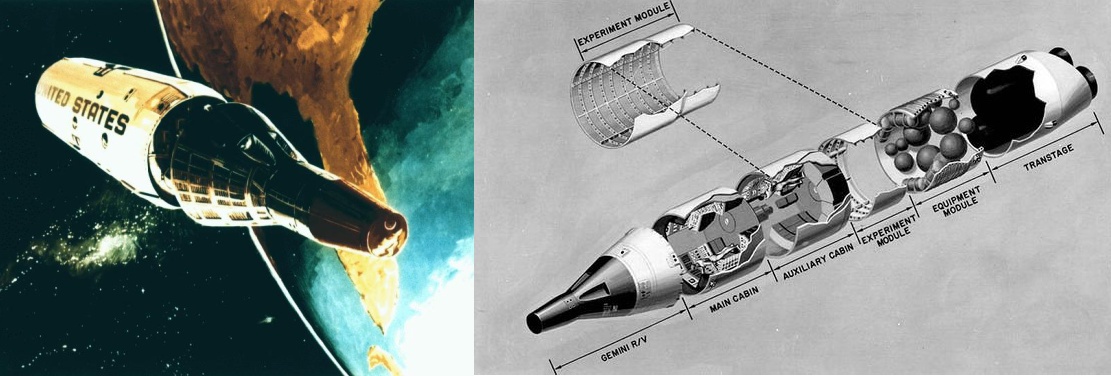
Historically, the Americans decided to embody the idea of military orbital stations. By 1963, it was known that man could be in space for several days without any problems. Accordingly, the idea arose of creating manned reconnaissance stations, whose crew could, in theory, work better, more flexibly and efficiently than unmanned reconnaissance satellites. A manned Orbiting Laboratory (MOL) weighing 14 tons was to be in orbit for up to 40 days with a crew of two people. The station was supposed to be used for photo reconnaissance, the ideas of “inspection” of enemy satellites were also suggested (although I can hardly imagine how they would do it - to change the orbit of a 14-ton station, powerful engines would be needed, which are not in the illustrations, but to launch one station at a satellite would be too expensive). No weapons were put on the station. After completing the mission, the crew occupied the seats in the modified Gemini spacecraft, which was launched as a monoblock together with the station, undocked and returned to Earth.
According to the MOL project, one OPS 0855 unmanned flight took place, in which an unknown amount of station equipment and a modified Gemini heat shield were tested, with a hatch for transfer to the station. In 1969, the project was closed because the experience of operating unmanned satellites reconnaissance aircraft was gained, and the manned station did not look so attractive.
Diamond

The US publicly announced plans to build MOL aroused interest in military space stations in the USSR. Chelomey Design Bureau began to develop the project of Almaz stations for similar tasks - mainly photo prospecting. The Almaz stations were to be output by the Proton, so they had a large mass of 19 tons, could be (and were) in orbit for months. The crew would fly to them on a separate “Union” or “TKS” , therefore several crews could work consistently at one station. The equipment of the station was serious enough and consisted mainly of photographic equipment:
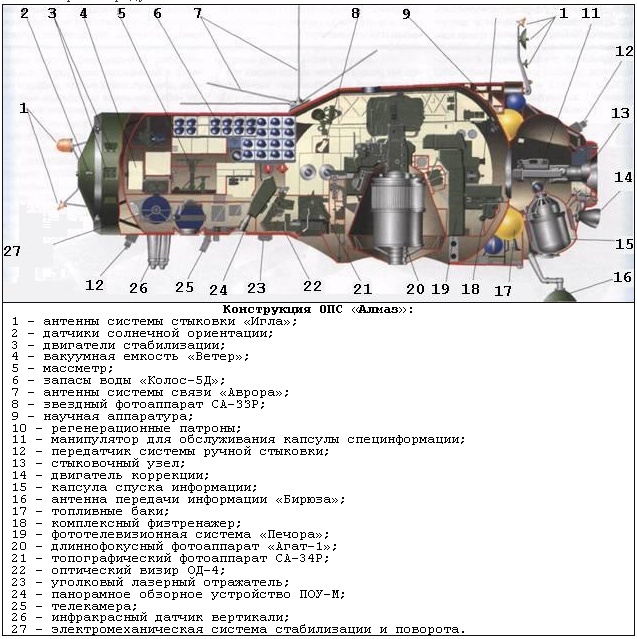
The most interesting on the diagram is not shown. "Almaz" was the only really existing spacecraft with weapons. According to the project, at the stations of the first stage an automatic aviation gun NR-23 was supposed to stand for self-defense (target range 300 m) from uninvited guests:

And at the station OPS-2, it is “Salyut-3”, she really stood and even shot! Shortly before the station was completed when flying in unmanned mode, the gun was successfully tested. At the stations of the second stage, two space-to-space missiles were supposed to stand, and it is even stated on the Internet that they were stationed at the Salyut-5 OPS-3 station, but I doubt it very much. Such a project would surely leave behind itself documents (design, manufacture, testing, mock-ups, instructions and simulators for use) and eyewitnesses. And the absence of such information leads one to assume that the matter did not go further than the project.
Due to the complex processes of convergence of military and civilian stations, "Diamonds" were designated as civilian "Salutes" and were launched along with them. In the 80s they flew completely without crew, like big photo reconnaissance satellites. Operational practice has shown that unmanned aerial vehicles are better suited for photo, radio and other intelligence.
The module "Spectrum" station "World"
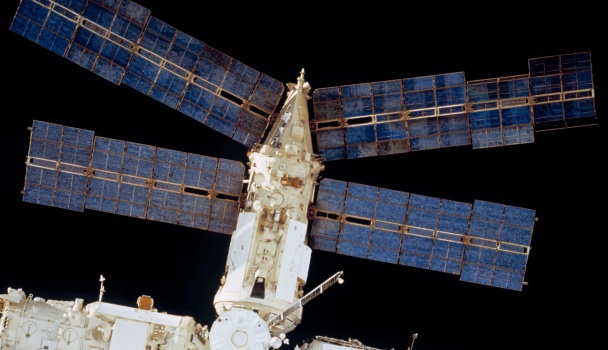
Initially, the Spectrum module was created for military research under the space reconnaissance and anti-missile defense program. Its main tool would be the Peony telescope and gateways for launching artificial targets for telescope calibration. However, according to other sources, full-fledged interceptor missiles should have been launched from it, here, unfortunately, there is some confusion in the sources. In any case, the military program was stopped, and the module had already flown in 1995 in a heavily converted civilian form, with American equipment added.
Fighter satellites
The fact that alien spy satellites are flying over your country with impunity has created a natural desire to be able to beat these satellites. Such systems have been created quite a lot, so they are grouped by country.
USA
Bold orion

Anti-satellite missile air launch. On October 13, 1959, in the first and only test, it passed 6.4 km from the Explorer 6 satellite, which would be enough to destroy the satellite if a nuclear warhead was used.
High virgo

Anti-satellite missile air launch. The first and only trials of September 22, 1959 ended in failure.
DM-15S, Program 437

Land-launch missile modifications ( Nike-Zeus air defense missiles, and Thor ICBMs) with very powerful combat units. Their detonation in space caused a powerful electromagnetic pulse, disabling all satellites in a large radius. A single number of missiles was on duty.
ASM-135 ASAT
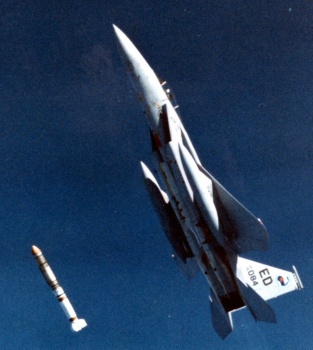
In 1982, the United States was surprised to find that the USSR had its own satellite destruction system. Therefore, the ASM-135 system was developed as a matter of urgency. Air launch missile, the carrier is the F-15 fighter. The defeat of the target is a direct hit. The first test - January 21, 1984, the first successful destruction of the satellite - September 13, 1985. It is alleged that produced 15 missiles, the program is closed in 1988.
RIM-161 Standard Missile 3

A ship-based missile to defeat satellites and combat units of ballistic missiles. The first test launch was 2001, the first successful destruction of a satellite was February 21, 2008. The defeat of the target is a direct hit. Already produced more than a hundred missiles, is on alert.
Interesting video test kinetic striking element
the USSR
IS, IS-MU

Anti-satellite satellite launched into orbit on a conventional launch vehicle (“Flight”, “Cyclone”). The first flight October 27, 1967 - "Cosmos-185". The last flight - June 18, 1982 - "Cosmos-1379". The defeat of the target occurs undermining the fragmentation warhead not far from the target. The satellite has its own engine and can maneuver. The system was in service allegedly until the end of the 1980s.
In more detail - here , here and here .
IS-MD "Outfit"
The project of an anti-satellite satellite with the possibility of hitting any targets up to the geostationary orbit based on the IS-MU base. The carrier - PH "Cyclone". Development started in 1988, discontinued, presumably in 1993. Source of
Contact
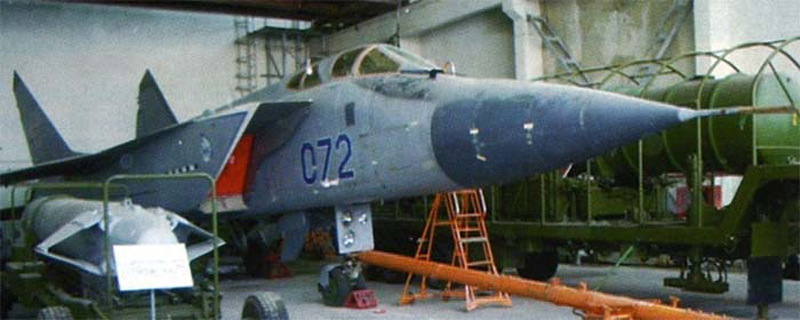
Draft air launch anti-satellite missiles. The carrier is the MiG-31. Development began supposedly in 1983, stopped, presumably in the 90s. Source of
Present tense
Presumably, Russia currently does not have anti-satellite weapons. However, given the high secrecy surrounding such projects, it is difficult to say something for sure.
China
SC-19
January 11, 2007, China shot down its satellite with a ground-based anti-satellite missile. The rocket was placed on a mobile chassis. The principle of defeat is a direct hit. Because of the secrecy of the details of the system are unknown.
Missile Defense Satellites
SOI
The Strategic Defense Initiative (SDI) is one of the symbols of the militarization of space. A program of literally cosmic proportions envisaged the creation of a layered missile defense consisting of:
Detection and targeting systems.
The Extended Range Interceptor (ERINT), the Homing Overlay Experiment (HOE), the Exoatmospheric Reentry-vehicle Interceptor Subsystem (ERIS), the Terminal High Altitude Area Defense (THAAD) system has grown from the latter.
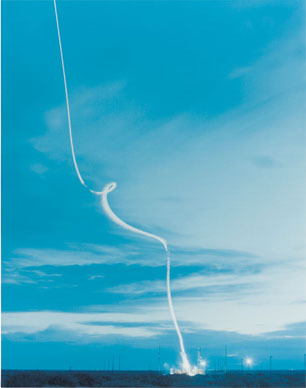
The launch of the THAAD rocket, the helix, is the burning of excess solid fuel.
Space systems : nuclear-pumped x-ray lasers, chemical lasers, orbital mirrors for ground-based lasers, atomic graphes , railguns, diamond pebbles.
Slides of '' diamond pebbles ''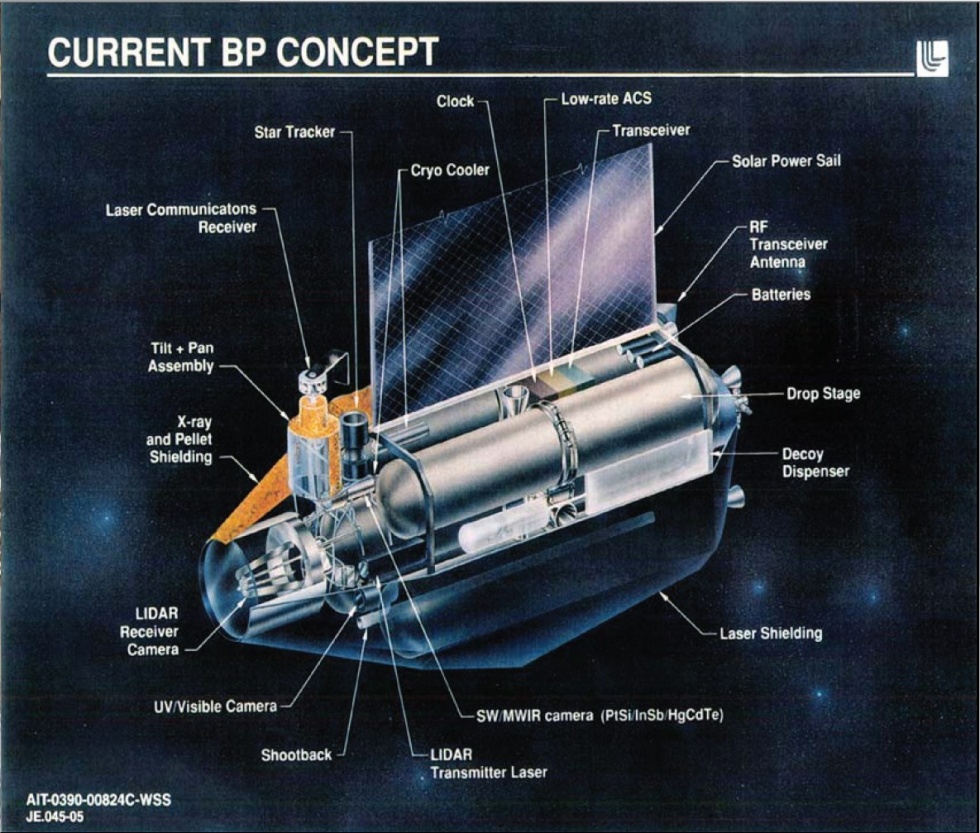
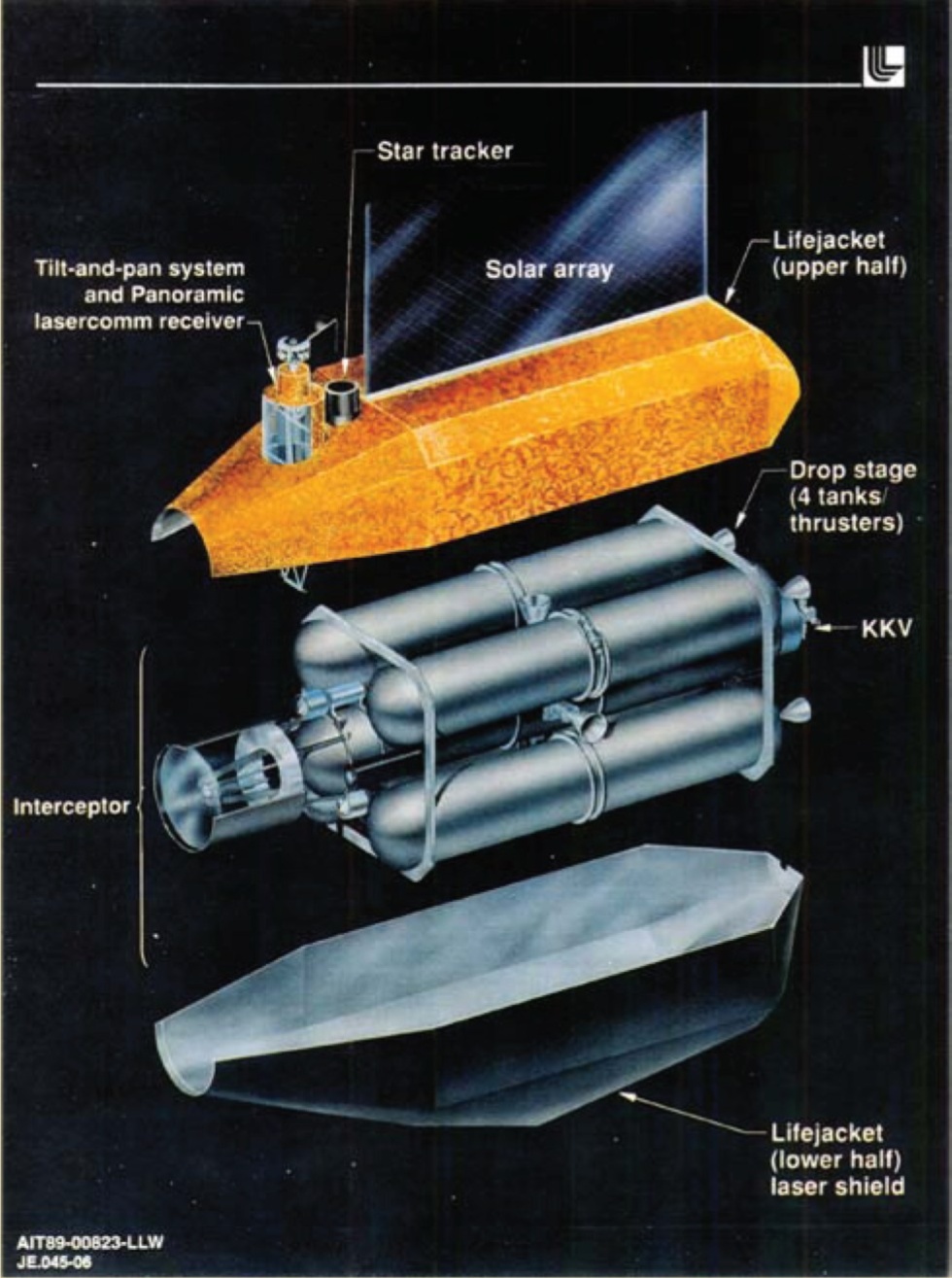
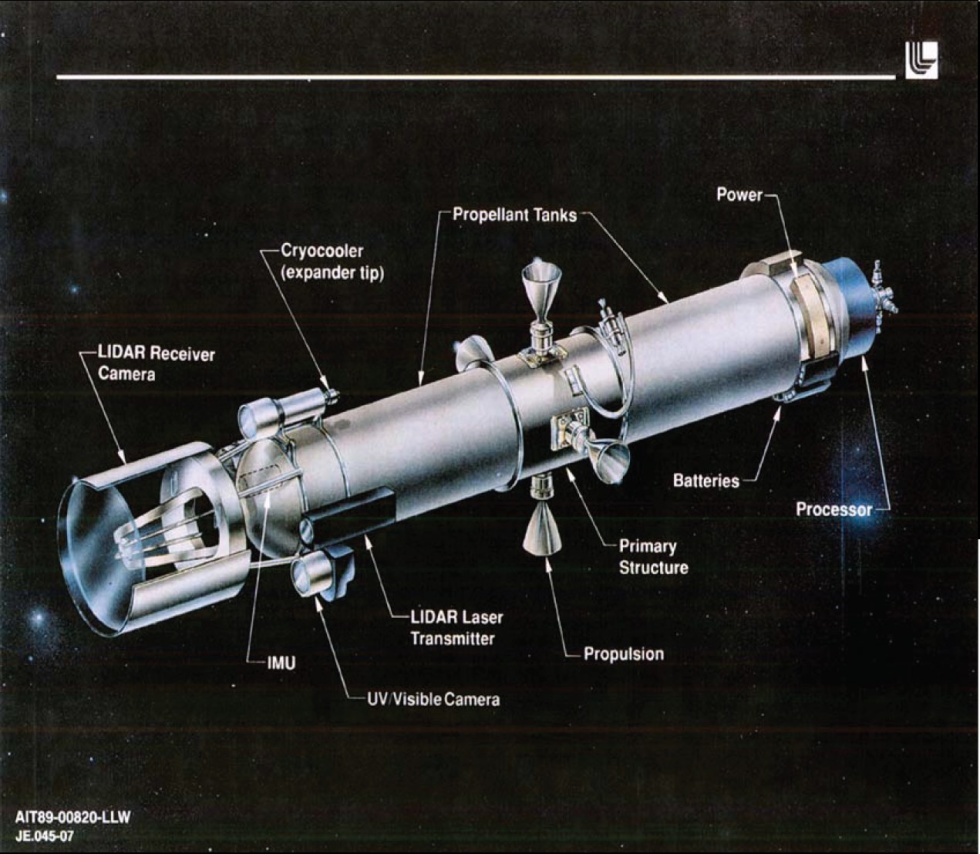



Interesting film, in English
However, almost all systems remained only in the pictures. The most promising system was considered “diamond pebbles” because of its relative simplicity, but it was not deployed. The PIO program was officially closed in 1994.
Soviet answer
The USSR did not stay away from high-tech military space. Projects "Skiff" with laser weapons and "Cascade" with rocket were created. Scythian:

The Skif model with a control system, but without weapons, was launched at the first launch of the Energia launch vehicle called the Polyus.
Cascade:

More details can be read here or here .
Warships
Military "Unions"
In parallel, the civilian "Union" was developed a whole set of various military modifications:
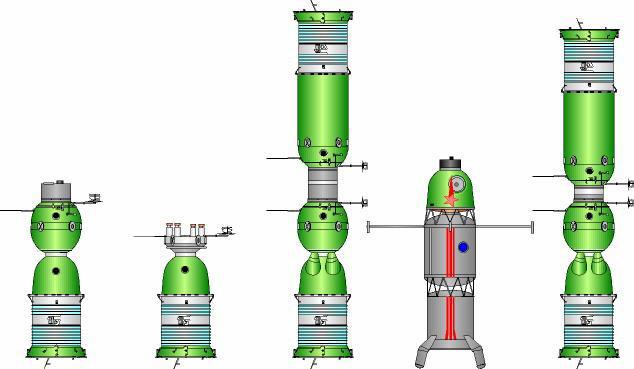
From left to right: Soyuz-P, Soyuz-PPK, Soyuz-R, Soyuz-VI, Soyuz-VI / OIC
- Soyuz-P: "interceptor". 1963 project. Intended for "inspection" of enemy satellites. One of the astronauts (crew of two people) had to go into outer space and examine the enemy satellite. Then the satellite could be destroyed, neutralized or stolen. The project has not been worked out in detail, its weaponry is unknown.
- Soyuz-PPK: Manned Interceptor. Project 1964. The project is more developed, instead of the risky spacewalk, the ship received eight short-range missiles that could destroy an enemy satellite from a safe distance.
- Soyuz-R: "scout". 1963 project. The reconnaissance ship of two parts, joined in orbit - the usual "Union" and the reconnaissance module, from which the Yantar photo reconnaissance satellites later grew
- "Soyuz-VI": "military research". Intelligence modification with the layout of the compartments as in MOL (descent vehicle in front) and a radioisotope generator as an energy source.
- Soyuz-VI / OIC. The modification of Soyuz-VI after the death of Korolev, Vasily Pavlovich Mishin. RTGs were removed, but a second module was added, similar to that of Soyuz-R.
Additional information: Source 1 , Source 2 , Source 3 , Source 4 , Source 5 .
Military "Apollo"
There was the idea of turning the Apollo into a warship with the same objectives - the inspection of satellites and, if necessary, destruction. Curiously, for destruction it was proposed to use a manipulator arm, and not guns / missiles. The large supply of Apollo’s characteristic speed made this modification very attractive. Source of
Orbital bombers
There were many projects of space bombers, which were united by the fact that they, as a rule, did not go beyond the projects and sketches:
Zenger bomber.
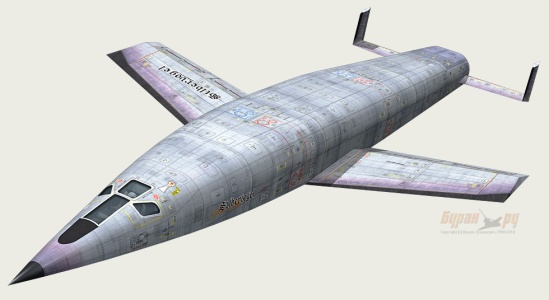
Bomi, Robo .
More pictures .

Scout, inspector, bomber Dyna-Soar X-20 .
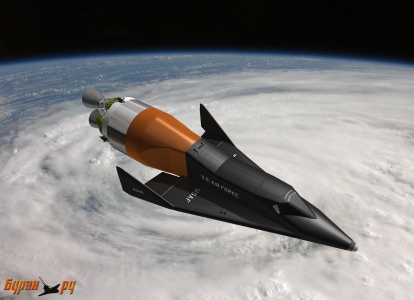
NAA Manned Bombardment and Control Vehicle .
More pictures .
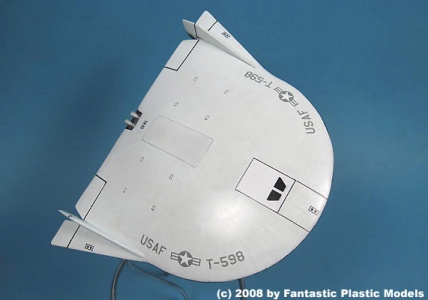
The only one with flying prototypes is Spiral / BOR .

Cruiser orion

The most apocalyptic of all projects. However, it is fully realized in the presence of an astronomical amount of money. Atomic-pulse space cruiser "Orion". Project early 1960s. He is the Deep Space Bombardment Force. The mass probably exceeded 10,000 tons. Armament:
- 200 thermonuclear warheads with a capacity of 1.5 megatons.
- 3 double-barreled nuclear howitzers Casaba, firing cumulative nuclear charges similar to marching charges.
- 3,127 mm modified naval artillery mounts 5 '' Mark 42 for self-defense
- 20 mm M61 Vulcan automatic cannons in retractable tower installations.
- The propulsion system (pulsed nuclear drive) could also be used as a weapon.
Source 1 , Source 2 , Source 3 , Source 4 .
Thanks to the community ru_deep_space for .
Conclusion
Fortunately, most of these projects were never implemented. Exploration turned out to be more profitable for unmanned satellites. Intercontinental missiles became the guardians of the world, and their comparative simplicity, low cost, high reliability and combat readiness saved us from nuclear platforms above our heads. And the tension between the superpowers has decreased, and yesterday's enemies together set up scientific experiments on the ISS.
All those who are concerned - with the last Defender of the Fatherland Day!
A small announcement for those interested in space exploration.
On February 27, 2014 at 18:00 Moscow time, Roskosmos TV invites you to a video call “Cosmonautics - yesterday, today, tomorrow” with the Hero of Russia Fyodor Nikolayevich Yurchikhin.
The hangout will be broadcast live on the Roskosmos television studio pages on Google+ ( https://plus.google.com/u/0/102310426765283353896/posts ) and on YouTube ( http://www.youtube.com/watch?v=rP6znaILDDw )
Fedor Nikolayevich Yurchikhin - cosmonaut of the Russian Federation, Hero of Russia
Born on January 3, 1959
The serial number of the world cosmonaut is 423, Russia - 98.
Status - Instructor-cosmonaut-test 1st class
Number of flights - 4
Flight duration - 536 days 2 hours 31 minutes
The number of spacewalks - 8
The duration of work in open space - 51 hours and 53 minutes
Questions to F.N. Yurchikhin can be asked here - https://plus.google.com/events/cskam4rego7144abe1c2ddmh34o
Source: https://habr.com/ru/post/213545/
All Articles